Toronto, Canada
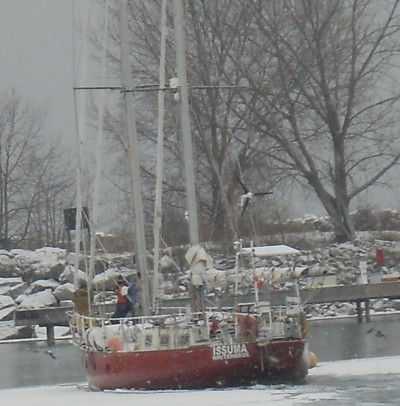 After a total of two hours (including the turn) to get thru 300m of 3-4″ (8-10cm) ice, we were free to exit the harbor. Once out of the harbor, we had a pleasant afternoon sail with mild temperatures, gentle winds and light snow.My neighbors at the marina took pictures and video of Issuma pushing thru the ice. There are pictures at Don Proctor’s Infrequent Photo Blog, and video on Joe Berta’s www.cruisingdog.com
After a total of two hours (including the turn) to get thru 300m of 3-4″ (8-10cm) ice, we were free to exit the harbor. Once out of the harbor, we had a pleasant afternoon sail with mild temperatures, gentle winds and light snow.My neighbors at the marina took pictures and video of Issuma pushing thru the ice. There are pictures at Don Proctor’s Infrequent Photo Blog, and video on Joe Berta’s www.cruisingdog.com
Monthly Archives: December 2010
Steady Progress
Toronto, Canada
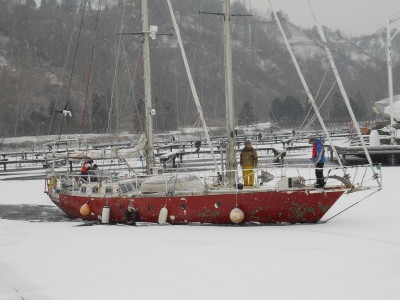 After getting thru the 90 degree turn, it got much easier to break the ice. The problem with Issuma in breaking this type of ice is that the bobstay (the pipe structure in front of the boat is called the bowsprit, the wire that supports the bowsprit from the bottom is called the bobstay) is low enough that it sometimes cuts the ice, instead of the hull riding up on the ice and then using its weight to break the ice. The bobstay supports the masts via the jibstay, so, even though I wasn’t using much power (to reduce strains), it is not that good for the bobstay to be cutting ice. Issuma is loaded heavily, and floats lower than it would in seawater (because freshwater is less buoyant), so the bobstay hits the ice more than it might otherwise. I think the solution is to remove the bowsprit (not a simple thing to do, it involves moving the jibstay back and shortening the jibstay and the jib and probably needing to compensate the sail area change forward by removing the roach from mainsail).
After getting thru the 90 degree turn, it got much easier to break the ice. The problem with Issuma in breaking this type of ice is that the bobstay (the pipe structure in front of the boat is called the bowsprit, the wire that supports the bowsprit from the bottom is called the bobstay) is low enough that it sometimes cuts the ice, instead of the hull riding up on the ice and then using its weight to break the ice. The bobstay supports the masts via the jibstay, so, even though I wasn’t using much power (to reduce strains), it is not that good for the bobstay to be cutting ice. Issuma is loaded heavily, and floats lower than it would in seawater (because freshwater is less buoyant), so the bobstay hits the ice more than it might otherwise. I think the solution is to remove the bowsprit (not a simple thing to do, it involves moving the jibstay back and shortening the jibstay and the jib and probably needing to compensate the sail area change forward by removing the roach from mainsail).
A Slow Turn
Toronto, Canada
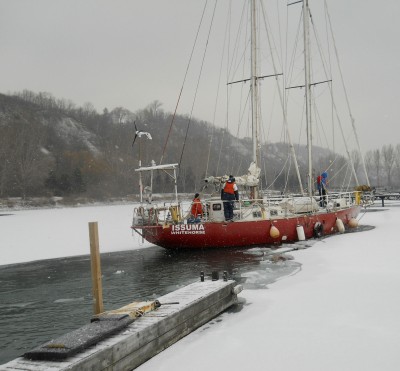 From where Issuma is (was) docked, getting out of the marina involves a 90 degree turn shortly after leaving the dock. This turn is quite difficult to do in ice, as it is hard to apply a lot of power in turning. Having two propellers helps a lot, but it still took an hour of back and forth and chopping at the ice with boathooks etc from the bow, to make this turn. The auxiliary rudder was removed (you can see it on the dock), as I wanted to try breaking the ice in reverse as well as forward, and felt that might put too much of a strain on it. Issuma can only break very thin ice in reverse, as otherwise the ice is too close to the propellers (which would be very expensive to have to fix or replace). I think the main rudder (steel, controlled by hydraulics) is strong enough to back down into ice (slowly) without straining it.
From where Issuma is (was) docked, getting out of the marina involves a 90 degree turn shortly after leaving the dock. This turn is quite difficult to do in ice, as it is hard to apply a lot of power in turning. Having two propellers helps a lot, but it still took an hour of back and forth and chopping at the ice with boathooks etc from the bow, to make this turn. The auxiliary rudder was removed (you can see it on the dock), as I wanted to try breaking the ice in reverse as well as forward, and felt that might put too much of a strain on it. Issuma can only break very thin ice in reverse, as otherwise the ice is too close to the propellers (which would be very expensive to have to fix or replace). I think the main rudder (steel, controlled by hydraulics) is strong enough to back down into ice (slowly) without straining it.
Thicker Ice
Toronto, Canada
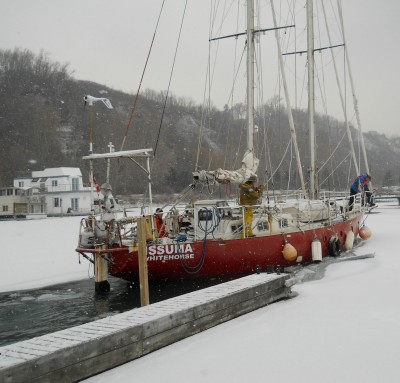 It is getting more difficult to go out sailing. The ice in the marina is now 3-4″ (8-10cm) thick. Issuma has gone backwards and forwards to break a path thru the ice.
It is getting more difficult to go out sailing. The ice in the marina is now 3-4″ (8-10cm) thick. Issuma has gone backwards and forwards to break a path thru the ice.
Smooth Ice
Toronto, Canada
 Customs cleared me into Canada the morning after I arrived, and then Martin and Magdalene came aboard for the sail to the marina I’d arranged a berth in (Bluffers Park Marina). It was a nice, pleasant, relatively warm (ie, above freezing) day with a light tailwind. We motored out of the harbor, then had a nice sail to near the marina, doused the sails, raised the keel most of the way and motored into the marina. My assigned dock in the marina was a long way from the entrance, so after entering the marina, we had about 300m off thin ice to plow through. This was no problem, the ice only being about 1/2″ (1.3cm) thick. In the picture, the boat is reversing towards the dock, and you can just see the ice that it has broken.
Customs cleared me into Canada the morning after I arrived, and then Martin and Magdalene came aboard for the sail to the marina I’d arranged a berth in (Bluffers Park Marina). It was a nice, pleasant, relatively warm (ie, above freezing) day with a light tailwind. We motored out of the harbor, then had a nice sail to near the marina, doused the sails, raised the keel most of the way and motored into the marina. My assigned dock in the marina was a long way from the entrance, so after entering the marina, we had about 300m off thin ice to plow through. This was no problem, the ice only being about 1/2″ (1.3cm) thick. In the picture, the boat is reversing towards the dock, and you can just see the ice that it has broken.
Cold Sailing continued
Lake Ontario
 After dawn, things got easier, as they often seem to with daylight. Several of the ropes thawed out and became easier to work with. The wind steadily increased to a Force 5 as we approached Toronto. The waves washed the salt (that I’d earlier spread on the deck to melt the snow) off the deck (but were not high enough to wash the salt off the pilothouse roof). Dropping the sails and motoring into Toronto harbor was straightforward. A cheerful harbor police officer asked me if I’d really come from Whitehorse (now that I’m in Canada, everyone knows where Whitehorse is (far north and inland, on a big river in the Yukon Territory), where I once lived and where the boat is registered. While preparing docklines, a boat which saw me singlehanding came out and offered to help with the docking. It is always nice to have help when docking.
After dawn, things got easier, as they often seem to with daylight. Several of the ropes thawed out and became easier to work with. The wind steadily increased to a Force 5 as we approached Toronto. The waves washed the salt (that I’d earlier spread on the deck to melt the snow) off the deck (but were not high enough to wash the salt off the pilothouse roof). Dropping the sails and motoring into Toronto harbor was straightforward. A cheerful harbor police officer asked me if I’d really come from Whitehorse (now that I’m in Canada, everyone knows where Whitehorse is (far north and inland, on a big river in the Yukon Territory), where I once lived and where the boat is registered. While preparing docklines, a boat which saw me singlehanding came out and offered to help with the docking. It is always nice to have help when docking.
Cold Sailing
Lake Ontario, New York
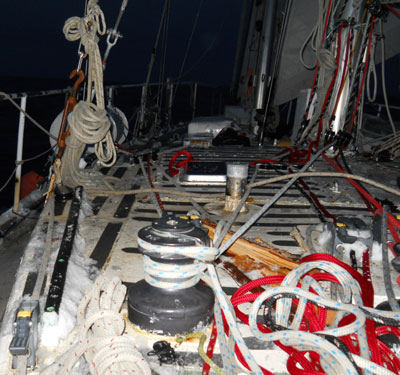 Dawn along the southern shore of Lake Ontario. After several days of shovelling snow while waiting for a favorable wind, the forecast indicated the break in the weather I needed was coming. The wind would not be favorable for long, so I left at night, just after the strong headwind died down, before it was to pick up from the south. I motored out of Rochester harbor, then anchored immediately outside the harbor to fix some engine problems. After a couple of hours, I was underway again, motoring with some sails up. The temperature was staying below freezing all night, but forecast to steadily rise as I went west along the shore as the southerly wind picked up. I had put salt over the deck to help melt the snow and ice that was on it. The salt helped, but the deck was still slippery in many places. I normally am attached to the boat at all times at sea via a safety harness that connects to a rope (jackline) that runs along the deck on each side of the boat. The trouble with this system in cold weather is that the rope running along the deck froze into the deck, and couldn’t be used. While I’ve done a fair amount of daysailing in winter with other boats, this was the first time I had gone sailing in below freezing conditions with Issuma. It was a learning experience. The rope clutches (which hold the ropes after you tighten them with a winch, so one winch can be used for multiple ropes) don’t really work with frozen ropes, as the rope diameter gets bigger, so it jams when trying to get it through the rope clutch. This could somewhat be worked around by using smaller ropes than what the rope clutch is designed for, but that means that in non-freezing conditions, the rope clutch will not hold as well (because the rope is too small for it). I hadn’t realilzed that when I installed the rope clutches.
Dawn along the southern shore of Lake Ontario. After several days of shovelling snow while waiting for a favorable wind, the forecast indicated the break in the weather I needed was coming. The wind would not be favorable for long, so I left at night, just after the strong headwind died down, before it was to pick up from the south. I motored out of Rochester harbor, then anchored immediately outside the harbor to fix some engine problems. After a couple of hours, I was underway again, motoring with some sails up. The temperature was staying below freezing all night, but forecast to steadily rise as I went west along the shore as the southerly wind picked up. I had put salt over the deck to help melt the snow and ice that was on it. The salt helped, but the deck was still slippery in many places. I normally am attached to the boat at all times at sea via a safety harness that connects to a rope (jackline) that runs along the deck on each side of the boat. The trouble with this system in cold weather is that the rope running along the deck froze into the deck, and couldn’t be used. While I’ve done a fair amount of daysailing in winter with other boats, this was the first time I had gone sailing in below freezing conditions with Issuma. It was a learning experience. The rope clutches (which hold the ropes after you tighten them with a winch, so one winch can be used for multiple ropes) don’t really work with frozen ropes, as the rope diameter gets bigger, so it jams when trying to get it through the rope clutch. This could somewhat be worked around by using smaller ropes than what the rope clutch is designed for, but that means that in non-freezing conditions, the rope clutch will not hold as well (because the rope is too small for it). I hadn’t realilzed that when I installed the rope clutches.
Getting Colder
Rochester, NY
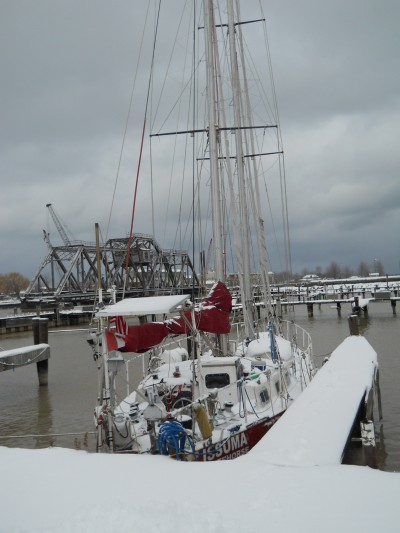 In Rochester, Shumway Marine had a big enough (40 ton) travelift so they helpfully hauled Issuma out and fixed the problematic thruhull, and welded over (closed permanently) three other thruhulls, so they could not cause problems over the winter (when the boat may be frozen in) and replaced some zinc anodes and we painted the bottom of the boat. After launching, in a mad rush to finish up enough of the rigging work to be able to leave on the fair wind that I had for only a short period of time, I left in mid-afternoon. I was still rigging lines at sea, before I could set all sails. Days are short in December, and the Coast Guard stopped me for a safety inspection, which took up more of the daylight time that I had to finish things underway. In the evening, with much still to be done, I turned back and returned to Rochester to await better weather. Better weather was forecast only after a week of strong headwinds and snow. I’ve been shoveling the snow twice daily for several days now–more keeps coming. Forecast is for the headwinds to die down, then become favorable late Thursday, so I have a little longer to continue getting ready to sail.
In Rochester, Shumway Marine had a big enough (40 ton) travelift so they helpfully hauled Issuma out and fixed the problematic thruhull, and welded over (closed permanently) three other thruhulls, so they could not cause problems over the winter (when the boat may be frozen in) and replaced some zinc anodes and we painted the bottom of the boat. After launching, in a mad rush to finish up enough of the rigging work to be able to leave on the fair wind that I had for only a short period of time, I left in mid-afternoon. I was still rigging lines at sea, before I could set all sails. Days are short in December, and the Coast Guard stopped me for a safety inspection, which took up more of the daylight time that I had to finish things underway. In the evening, with much still to be done, I turned back and returned to Rochester to await better weather. Better weather was forecast only after a week of strong headwinds and snow. I’ve been shoveling the snow twice daily for several days now–more keeps coming. Forecast is for the headwinds to die down, then become favorable late Thursday, so I have a little longer to continue getting ready to sail.
Up With the Masts 4
Sodus Point, NY
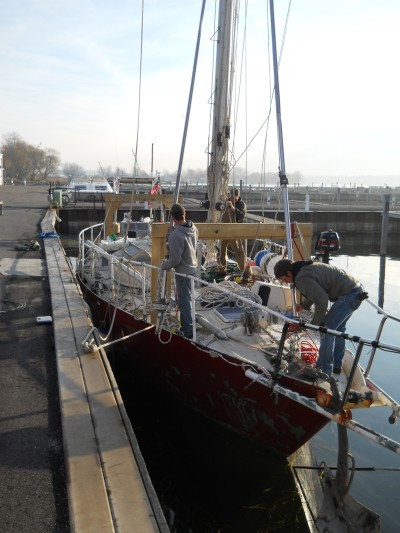 The masts went up in the morning and early afternoon, then I moved to a slip in the marina for the gale that was coming that night. I was busy attaching the rigging wires (the new ones were cut to fit after the masts were in place) until dark. I spent a few more days in Sodus Point, working on tuning the rigging and reconnecting electrical wires, and starting to get sails attached. I needed to haul the boat out to fix a thruhull problem, and the marina in Sodus Point was closing the entire week for Thanksgiving, so when I had a light, favorable wind, I motored (and had one sail up–the rest weren’t ready yet) to Rochester.
The masts went up in the morning and early afternoon, then I moved to a slip in the marina for the gale that was coming that night. I was busy attaching the rigging wires (the new ones were cut to fit after the masts were in place) until dark. I spent a few more days in Sodus Point, working on tuning the rigging and reconnecting electrical wires, and starting to get sails attached. I needed to haul the boat out to fix a thruhull problem, and the marina in Sodus Point was closing the entire week for Thanksgiving, so when I had a light, favorable wind, I motored (and had one sail up–the rest weren’t ready yet) to Rochester.
Up With the Masts 3
Sodus Point, NY
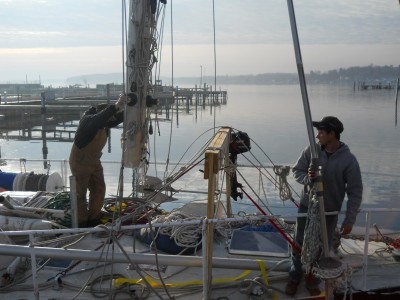 Yard crew putting the foremast in position.
Yard crew putting the foremast in position.